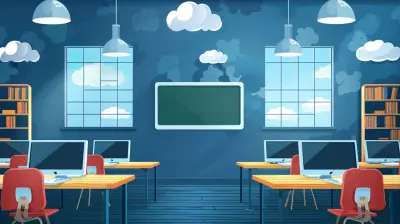Unlocking the Secrets of Motivation in the Classroom
2 August 2025
Let’s face it: getting students genuinely excited about learning can sometimes feel like trying to herd cats—frustrating, unpredictable, and downright exhausting. But what if we told you there’s a better way? What if motivation in the classroom isn't some magical unicorn but something you can understand, nurture, and amplify?
In this article, we’re diving deep into the nitty-gritty of what really drives student motivation. Forget cookie-cutter strategies and lifeless lectures—because unlocking the secrets of motivation is all about connecting, inspiring, and empowering your learners from the inside out.
Why Motivation in the Classroom Matters
Ever tried teaching a topic to a room full of uninterested students? You can practically feel the boredom crawling up the walls. The truth is, motivation isn’t just a “nice-to-have”—it’s the engine that drives learning. Without it, teaching becomes a one-way street with not much traffic coming in your direction.When students are motivated:
- They pay attention more.
- They retain knowledge better.
- They participate actively.
- And—most importantly—they enjoy the process.
Motivation transforms the classroom from a place of obligation into a hub of curiosity and growth.
Intrinsic vs. Extrinsic Motivation: What’s the Deal?
Before we dig deeper, let’s get this straight. There are two main types of motivation:- Intrinsic Motivation – This comes from within. Students learn because they want to. They’re curious. They find enjoyment or meaning in the task itself.
- Extrinsic Motivation – This is driven by external rewards or consequences—like grades, praise, stickers, or avoiding punishment.
Both types can be useful. But if your goal is to create lifelong learners—not just test-takers—then tapping into intrinsic motivation is where the real magic happens.
The Psychology Behind Student Motivation
Motivation doesn’t happen by chance. It’s deeply connected to human psychology. Here are a few core theories to keep in your back pocket:1. Self-Determination Theory (SDT)
This theory suggests that people are most motivated when three basic psychological needs are met:- Autonomy: The need to feel in control of one’s own actions.
- Competence: The need to feel effective and able to succeed.
- Relatedness: The need to connect with others.
When your classroom taps into these three areas, motivation doesn’t just increase—it may skyrocket.
2. Growth Mindset
Coined by Carol Dweck, a growth mindset is the belief that abilities can be developed through dedication and hard work. Praising effort over ability encourages students to keep trying—even when things get tough.3. Maslow’s Hierarchy of Needs
If basic needs (like safety, food, or emotional support) aren’t being met, don’t expect motivation to kick in. Sometimes, before you can engage the brain, you have to take care of the heart.
Practical Strategies to Boost Motivation in the Classroom
Okay, theories are great—but how do they translate into real-world classrooms? Let’s break down some practical, proven strategies that work.1. Give Students a Voice
Want students to care about their learning? Let them be part of the decision-making.Offer choices in assignments, readings, or project formats. Something as simple as picking a topic for a presentation can make a world of difference. Control breeds ownership. Ownership breeds motivation.
2. Set Clear, Achievable Goals
Goals give students something to aim for—and when those goals are realistic, they provide a sense of accomplishment that fuels further motivation.Use SMART goals:
- Specific
- Measurable
- Achievable
- Relevant
- Time-bound
Break big tasks into smaller milestones. And celebrate progress, no matter how small.
3. Make Learning Relevant
Ever heard a student ask, “When will I ever use this in real life?” That's a red flag for a disconnect between your material and their interests.Tie lessons to real-world contexts. Use examples they care about—music, sports, pop culture, or current events. Relevance makes information sticky.
4. Create a Safe, Supportive Environment
Fear kills curiosity. If students are afraid of making mistakes, they won’t take the risks required to learn.Build a classroom culture where mistakes are not just accepted—they're celebrated. Offer constructive feedback, encourage collaboration, and make sure every student feels seen and heard.
5. Use Variety and Surprise
Routine is comforting—but predictability can be a snooze-fest. Mix up your teaching methods: use videos, games, group work, debates, or hands-on activities.Throw in a twist once in a while. Maybe it’s a surprise guest speaker, a new seating arrangement, or an outdoor lesson. A little unpredictability keeps students on their toes—in a good way.
6. Foster Peer Relationships
Students are social creatures. Collaborative learning taps into their natural desire to connect with one another.Use group projects, peer reviews, and discussion circles. When students are engaged socially, they’re often more engaged academically.
7. Give Timely, Meaningful Feedback
You wouldn’t keep bowling if you never got to see where the pins landed, right? The same goes for students. Feedback isn’t just about correcting mistakes—it’s about guiding growth and validating effort.Be specific. Be kind. And most importantly—be quick. The sooner they get it, the more it matters.
Technology: Friend or Foe?
Let’s address the digital elephant in the room. Technology can either be a powerful motivator… or a major distraction.When used intentionally, tools like Kahoot, Flip, Google Classroom, and educational apps can make learning more interactive and personalized. But if tech is just replacing paper without adding value, it’s not going to boost motivation.
Use tech to connect students with content in fresh, exciting ways—not just to tick a box.
The Role of Teachers: More Than Just Instructors
Teachers aren’t just deliverers of content—they're motivators, mentors, and sometimes even magicians.Your passion is contagious. If you’re fired up about a subject, chances are, some of that fire will catch on. But if you're burnt out or disengaged, students will pick up on that too.
Take care of yourself. Inspire by example. And never underestimate the power of a genuine “I believe in you.”
Motivation Isn’t One-Size-Fits-All
Here’s the truth: not every student is going to be motivated by the same thing. Some need rewards. Some need relevance. Others need simply to be understood.Pay attention. Notice patterns. Ask questions like:
- What lights them up?
- When do they zone out?
- What are they passionate about outside of school?
The more you know your students, the better you can tailor your motivational toolbox.
Long-Term Strategies for Sustained Motivation
Short bursts of motivation are easy. Sustained motivation? That’s the real challenge. Here’s how to keep the fire burning all year long:1. Build Relationships
Know your students as individuals. Learn their names fast. Remember the little things. Show up consistently. Motivation grows where connection lives.2. Reflect and Adjust
No strategy will work forever. Be willing to pivot. Ask for student feedback periodically and tweak your approach. Flexibility shows that you care and builds trust.3. Integrate Social Emotional Learning (SEL)
Emotional intelligence affects motivation. Help students develop skills like self-awareness, empathy, and self-regulation. When they feel better, they learn better.Signs Your Motivation Strategies Are Working
Not sure if it’s clicking? Look for signs like:- Increased participation.
- More thoughtful questions.
- Students helping each other.
- Improved attendance.
- A buzz of energy in the room.
And the best sign? When students start pushing themselves—without you having to nudge them.
Final Thoughts: Motivation Is a Muscle
Let’s be real: you’re not going to crack the code of motivation in one day. It takes patience, trial and error, and a whole lotta heart. But here’s the good news: motivation isn’t a mystery—it’s a skill you can build.Like any muscle, it grows with use. The more you work at understanding and applying these motivations strategies, the stronger your classroom will become. The mood shifts. The energy lifts. And learning? It becomes something students look forward to—not something they endure.
So, ready to unlock the secrets of motivation in your classroom? It’s all there—just waiting for you to turn the key.
all images in this post were generated using AI tools
Category:
Educational PsychologyAuthor:

Eva Barker
Discussion
rate this article
1 comments
Kristina Gill
In the heart of learning's embrace, Motivation dances, a fleeting grace. Unlock its secrets, let passion ignite, In every classroom, dreams take flight. Inspire, connect, and shine the light.
August 18, 2025 at 4:59 AM

Eva Barker
Thank you for capturing the essence of motivation in education so beautifully! Your words perfectly reflect the transformative power of passion and inspiration in the classroom.


